The battle of Seattle
The first major protest against global inequality, famine, poverty and climate change erupted on the streets of the American city of Seattle exactly 20 years ago. As an eyewitness to those events, the journalist Paul Coleman examines the legacy of an event that shook the world.
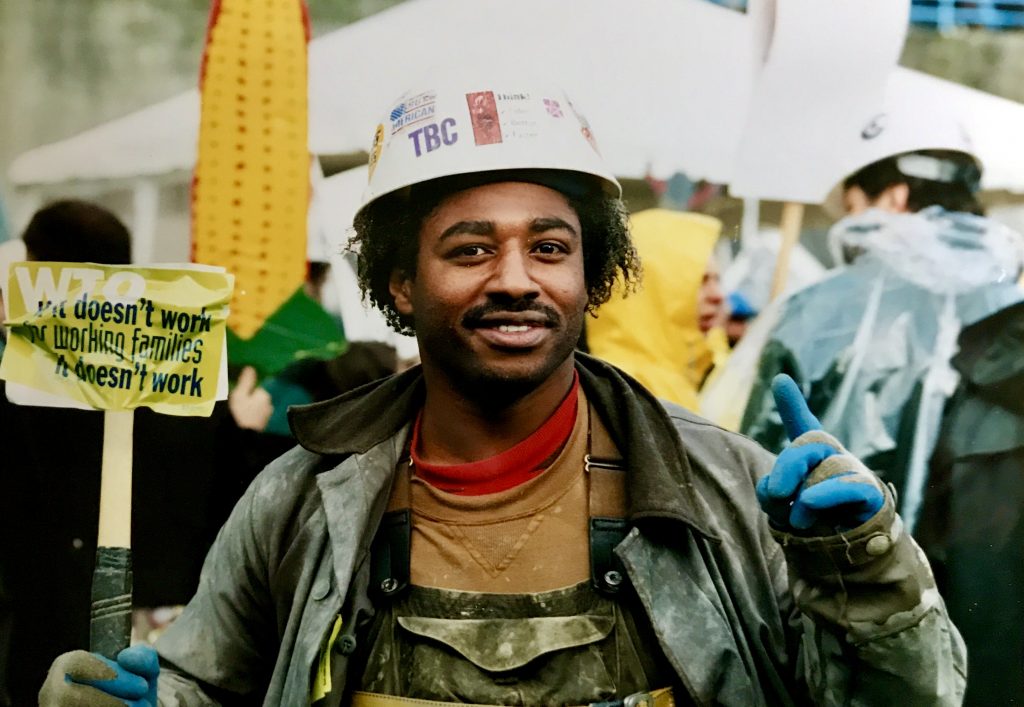
Rewind twenty years to Tuesday, 30 November 1999. Thousands of people march through the windy streets of the north-west American city of Seattle.
The protestors target politicians and bureaucrats from 134 member countries gathering in Seattle for the third biannual meeting of the World Trade Organisation (WTO), the supranational body that controls 90% of global commerce.
They are protesting against the WTO’s planned launch of a ‘Millennium Round of negotiations’. The protestors believe these negotiations will impose a crippling agenda of ‘globalisation’ – a new phase of late 20th Century capitalism – on poorer people and their countries.
‘Invisible’ regime
Protestors say the WTO, formed in 1995, acts as an unelected, secretive and almost ‘invisible’ regime that seeks to transfer political and economic power to profit-seeking corporations and their shareholders through ‘free trade’, deregulation and privatisation.
They say the WTO seeks to impose these elements of globalisation on a vast array of human life, including intellectual property rights, food safety, finance and investment, and on the environment.
Globalisation will actively subordinate working peoples’ income security, health and social welfare to the interests of global capital.
Demand
Protestors believe WTO-led globalisation will even modify, commodify and patent the genetic structures of life itself for private ownership and profit. Commonly owned fresh water and indigenous crop and plant seeds will be ‘globalised’.
The WTO has the power to strike down domestic laws, social welfare programmes and nationalisation policies.
The WTO can demand compliance with its rules from elected provincial, state, county and city governments. It can impose economically severe trade sanctions as disciplinary penalties for non-compliance.
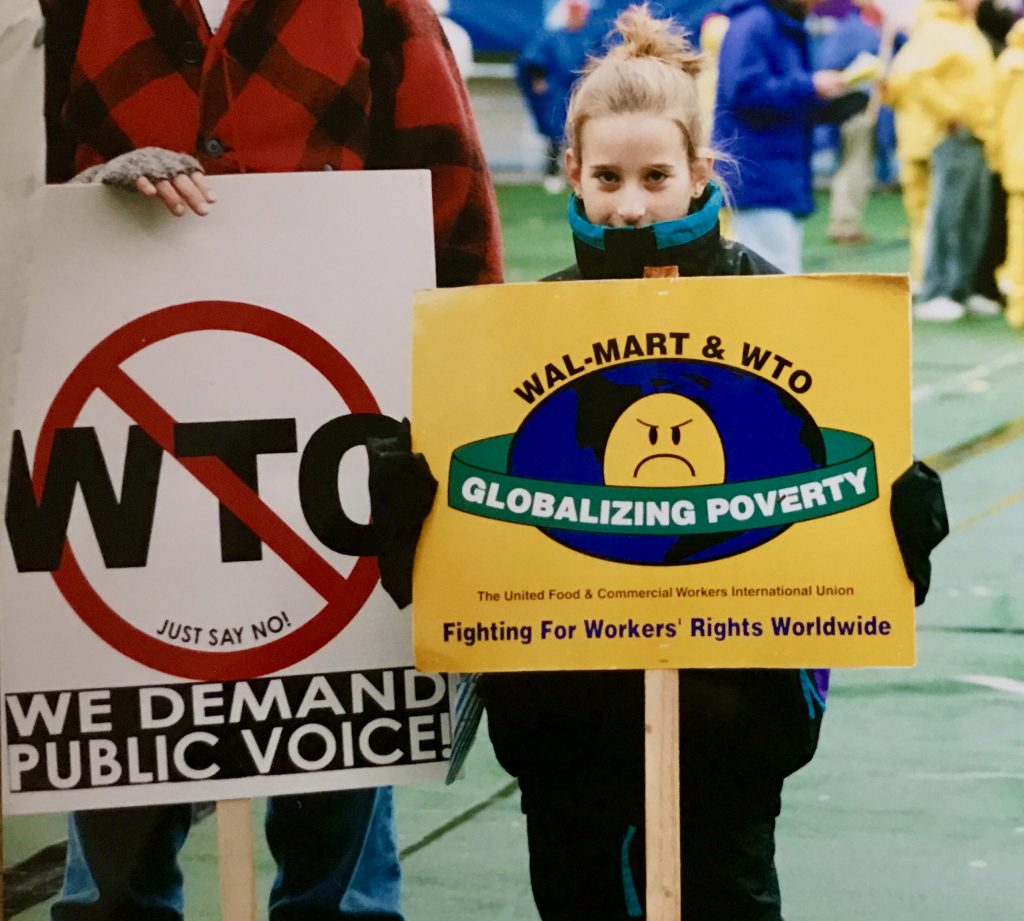
‘Free trade’
Politicians gathering in Seattle want the WTO to be even more powerful in order to change its rules to further reduce trade barriers. They say greater ‘free trade’ will allow producers in poorer countries to gain access to richer countries’ markets.
Politicians, bankers and corporations claim globalisation and ‘free trade’ is a panacea for all of the world’s economic ills and social perils. They say further liberalisation of WTO rules will spur growth and spread prosperity.
For instance, they say that net capital investment now flows into cities such as Jakarta in Indonesia. However, the protestors say unregulated capital inflows into poorer countries vastly widen gaps between rich and poor. For instance, children in Jakarta slums have to use makeshift latrines that hang over the river less than a mile from the city’s affluent business centre.
Fair trade
Protestors also believe new WTO rules will allow the United States to flood poorer countries with cheap American goods at the expense of those countries’ indigenous producers. They demand a global system of ‘fair trade’, not free trade.
Globalisation, in these ways, will widen the gap between the very richest people in the world and the rest of the world’s people. This is why the protestors actively seek to block the WTO in Seattle, a host city hitherto best known for Boeing, Microsoft, Starbucks and for ‘Frasier’, the hit TV comedy.
I arrive in Seattle on Thursday 25 November 1999 on Thanksgiving Day, a national holiday in the United States where families celebrate the harvest and other blessings of the past year. The city is quiet. Only Starbucks is open.
Decorative street lights show Seattle is already prepared for the upcoming Christmas holiday but the next few days will show the ‘Emerald City’ is not prepared to peacefully police mass anti-globalisation protests on its streets.
Chain and lock
By Tuesday 30 November, anti-globalisation hackers have rendered the WTO website unusable.
Ten thousand protestors blockade Seattle’s Washington State Convention and Trade Centre in the early morning. Some chain and lock themselves to railings. Others perform street theatre.
Their sit-ins block delegates from getting to the WTO meeting. Not far away some 25,000 workers and trade unionists rally at Seattle’s Memorial Stadium and then march through the city’s streets towards the Convention Centre.
Seattle’s dock workers close the city’s port, followed by dock workers in other US coastal cities. Four thousand Canadian workers cross the nearby border to join the Seattle protests.
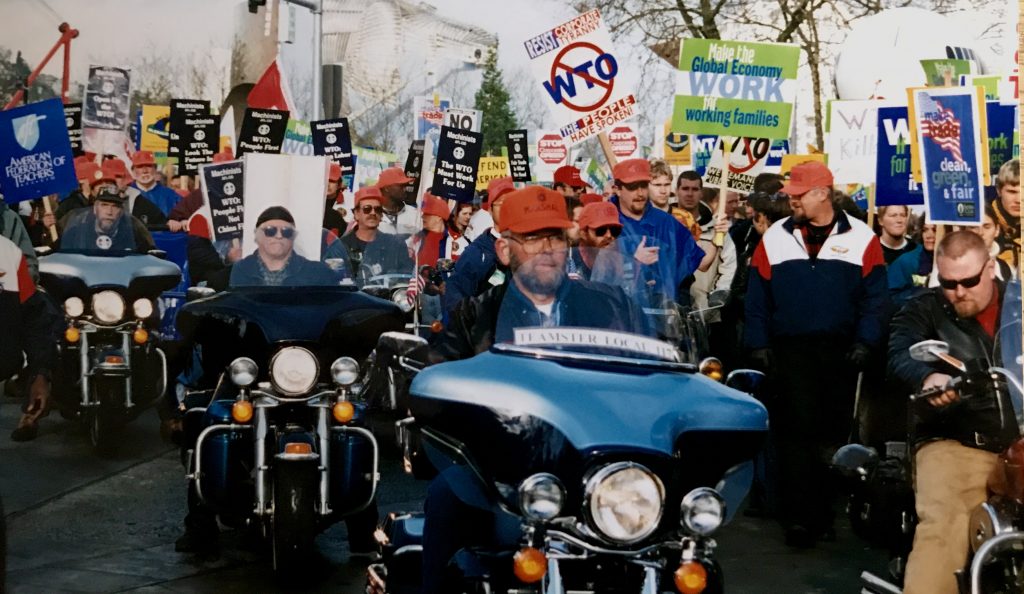
Bové
Protestors give a hero’s welcome to French farmer and activist José Bové. In August, Bové and his colleagues had ‘dismantled’ a McDonald’s restaurant in Millau; a symbolic protest against a WTO ruling that the United States had the right to export hormone-injected beef to Europe.
European countries resisted the WTO rule. The United States then retaliated by imposing heavy duties on European products, including Roquefort, a cheese Bové produces on his farm.
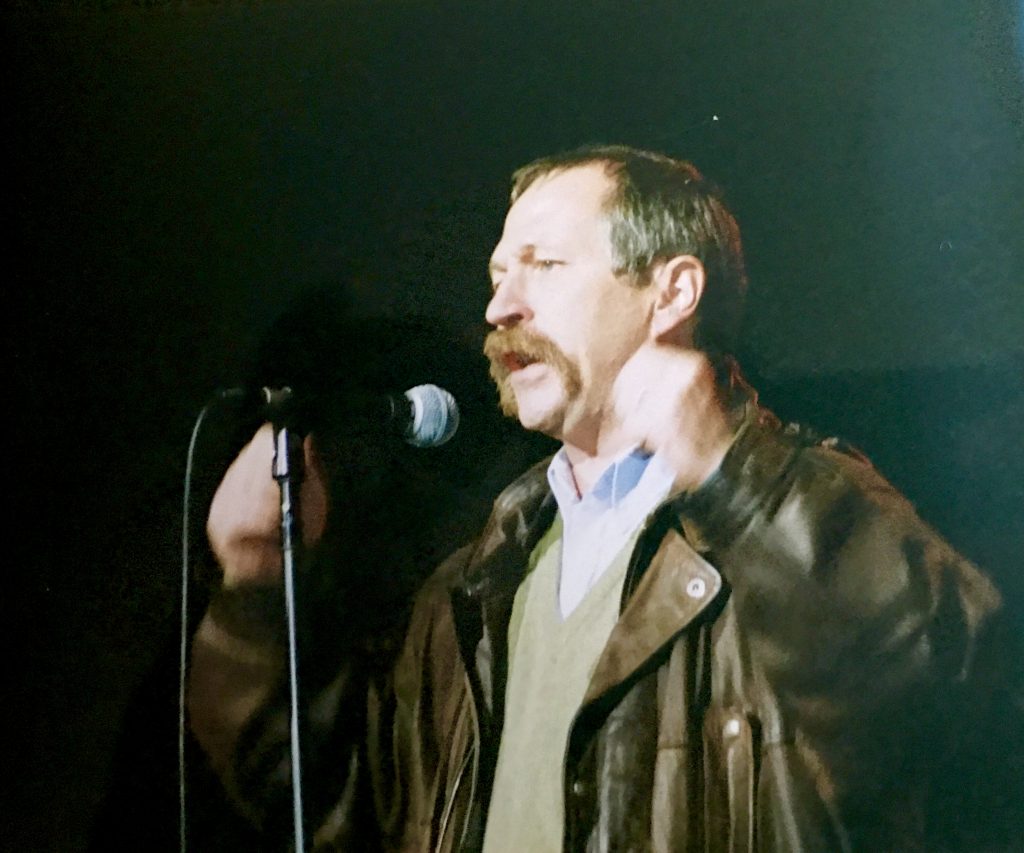
‘Swoosh’
Seattle police chief Norm Stamper deploys riot police with batons who are photographed wearing gloves branded with the Nike ‘swoosh’. Protestors say this symbolises how the police are working ‘hand-in-glove’ to protect the WTO and its agents of globalisation.
Stamper deems these peaceful protests to be civil disobedience. Tensions mount. Riot police then fire pepper spray directly into the faces of ‘sit-in’ protestors.
Some protestors retaliate by throwing placards, sticks and water bottles. Later, smaller bands of ‘anarchists’ will attack downtown Seattle properties owned by Starbucks and Nike, two corporations that epitomise globalisation.
They set fire to rubbish bins and break shop windows. Police respond with tear gas, concussion grenades and rubber bullets. Mayhem ensues.
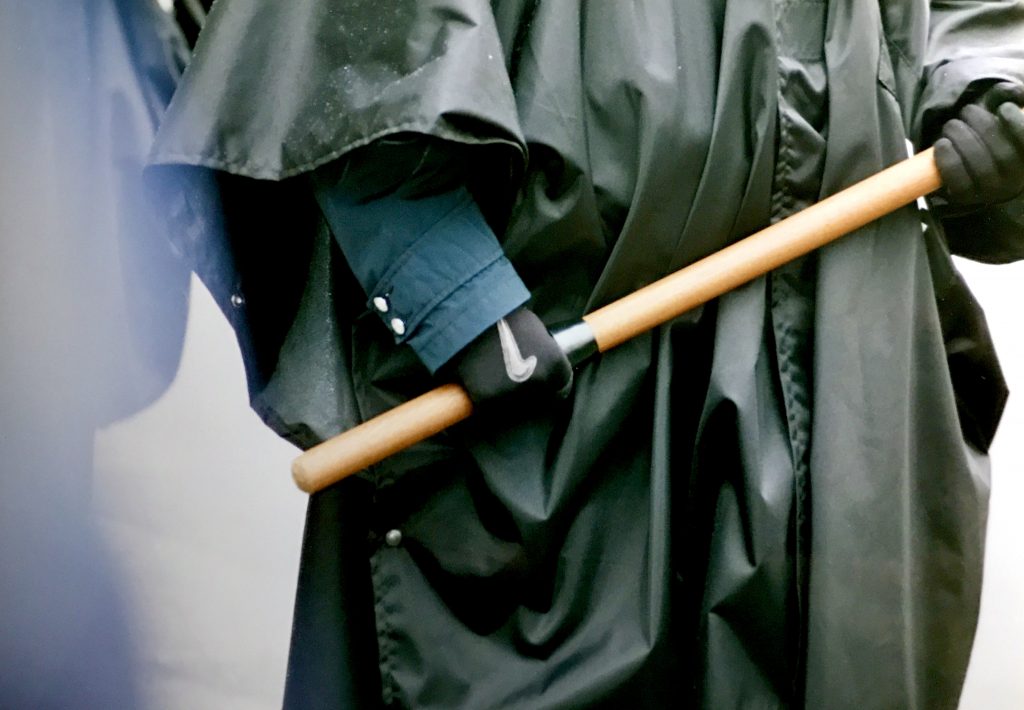
Curfew
Mayor of Seattle Paul Schell seeks to quell the protest before President Bill Clinton arrives on Wednesday 1 December. Schell declares a 7pm-7am 50-block downtown curfew.
At least 500 hundred protestors and other Seattle citizens are arrested for ignoring Schell’s curfew.
Thousands of protestors stage sit-ins outside the Seattle Police Department on Thursday and Friday. President Clinton hastily makes a speech near to Seattle’s docks.
On Friday 3 December, the protests and chaos force WTO Director Mike Moore and United States Trade Representative Charlene Barshefsky to suspend the WTO meeting.
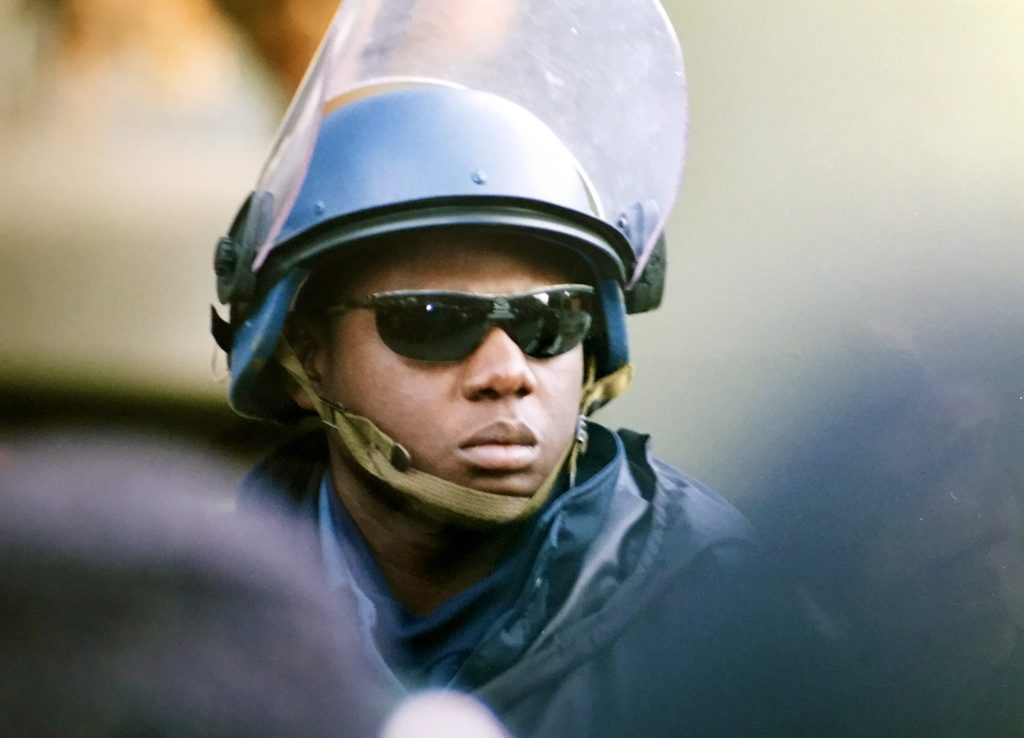
Legacy
The WTO leaves a bitter legacy for the city of Seattle and Washington State. Property damage runs to millions of dollars. Protestors begin to launch a mass of lawsuits against police for breaching their civil rights.
Seattle police chief Norm Stamper will much later express regret for firing tear gas and rubber bullets at non-violent demonstrators.
But what is wider ongoing legacy of the ‘battle of Seattle’?
The mass protests are the first to be organised largely by the web and to be amplified by social media. In this way, what happened in Seattle proves to be a forerunner for 21stCentury anti-globalisation protests in cities around the world, such as Genoa, Athens, Madrid, Tunis, Cairo and Bahrain.
Some of these later protests against inequality, price rises, gentrification, repression and the Iraq war evolve into more lasting progressive radical movements, such as UK Uncut, Occupy, Syriza in Greece, Podemos in Spain, the Gilet Jaunes (Yellow Vests) in France, and Extinction Rebellion.
Ominously, of course, the reactionary far right will also take to the streets and use social media to ferment their ideologies of nationalism, fundamentalism and racist hate.
Blocs
Ten years after Seattle, unregulated banks bring the global economy to the verge of financial meltdown. Working people pay for the bankers’ folly and greed through a decade of austerity that cuts wages and public services, limiting what hundreds of millions of people can do with their lives.
Twenty years after the ‘battle of Seattle’, global capitalism veers away from WTO-styled globalisation towards fierce competition between economic blocs – China, the United States, Russia and the European Union.
Yet the basic reasons why thousands of people took to the streets of Seattle in 1999 remain even more prevalent in 2019.
Capitalism continues to transfer money in London, the UK and throughout the rest of the world from working people who would spend it in the ‘real economy’ to extremely wealthy ‘high net worth individuals’ who hoard this wealth in real estate and tax havens.
Profit under 21st Century capitalism fails to create secure jobs with proper wages. Profit fuels only more wealth for the already ultra-wealthy.
Promise
Back in 1999, US President Bill Clinton and UK Prime Minister Tony Blair traipsed the world promising people that capitalism will deliver economic security, prosperity, peace and environmental protection for everyone.
The ‘battle of Seattle – and every subsequent protest inspired by that event – represents widespread frustration at the complete failure of world leaders to deliver on that promise.
In 2019, millions of people though still cling to capitalism out of fear rather than from a genuine hope that capitalism will guarantee a better life for their children.
Meanwhile, corporate financial cyber-capital grows money on glowing screens, way beyond the reach of the real economy’s need for capital investment in proper jobs, services and infrastructure.
In 1999, politicians like Blair and Clinton promised capitalism in the 21st Century will ‘raise all boats’.
Twenty years on, it’s clear capitalism merely lifts a handful of luxury yachts.
Streets
Capitalism in the 21st Century accelerates poverty, economic insecurity, war, famine, climate change, environmental destruction, species extinction, and the social cleansing of working people from major cities.
This is why people are protesting on the streets of Baghdad, Beirut, Cape Town, Hong Kong, La Paz, Paris, Quito, Santiago and Tehran – just as they did in Seattle in 1999.
Twenty years on, the battle of Seattle still rages.
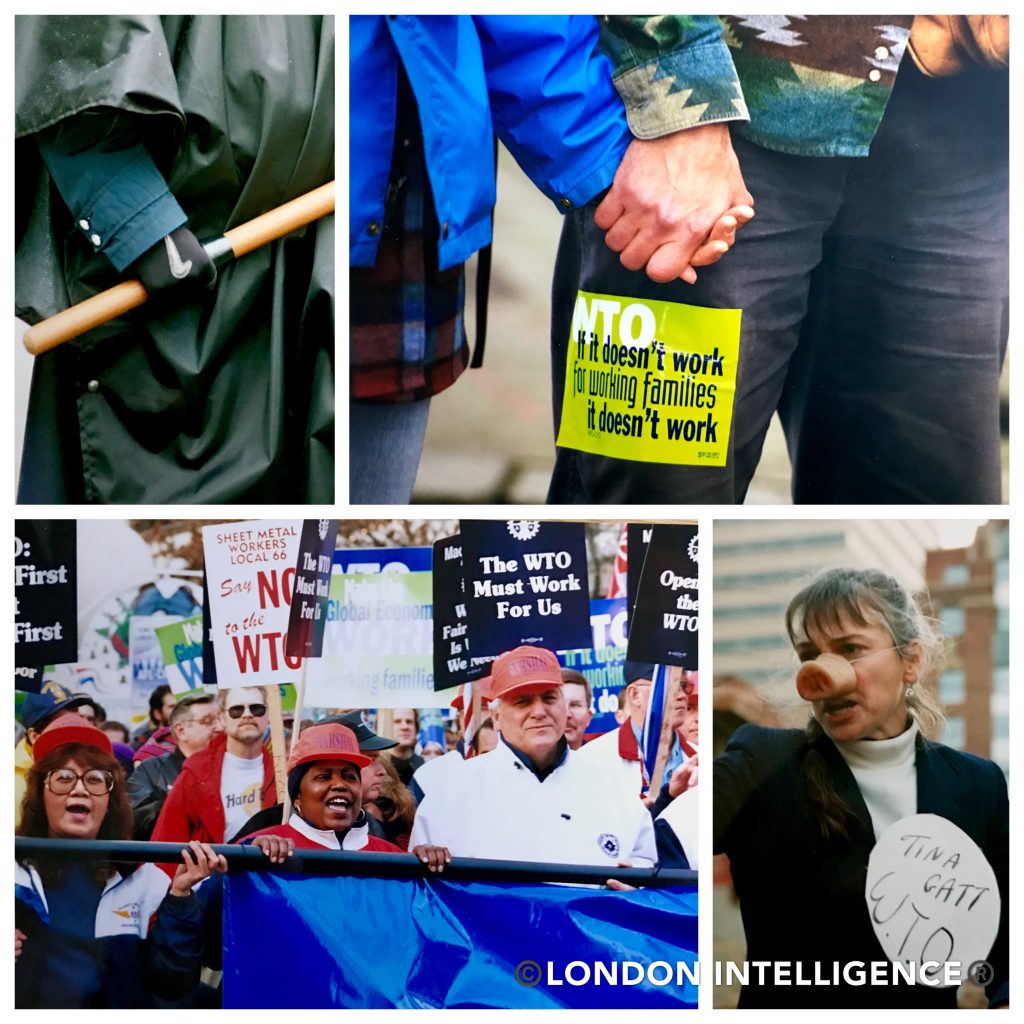
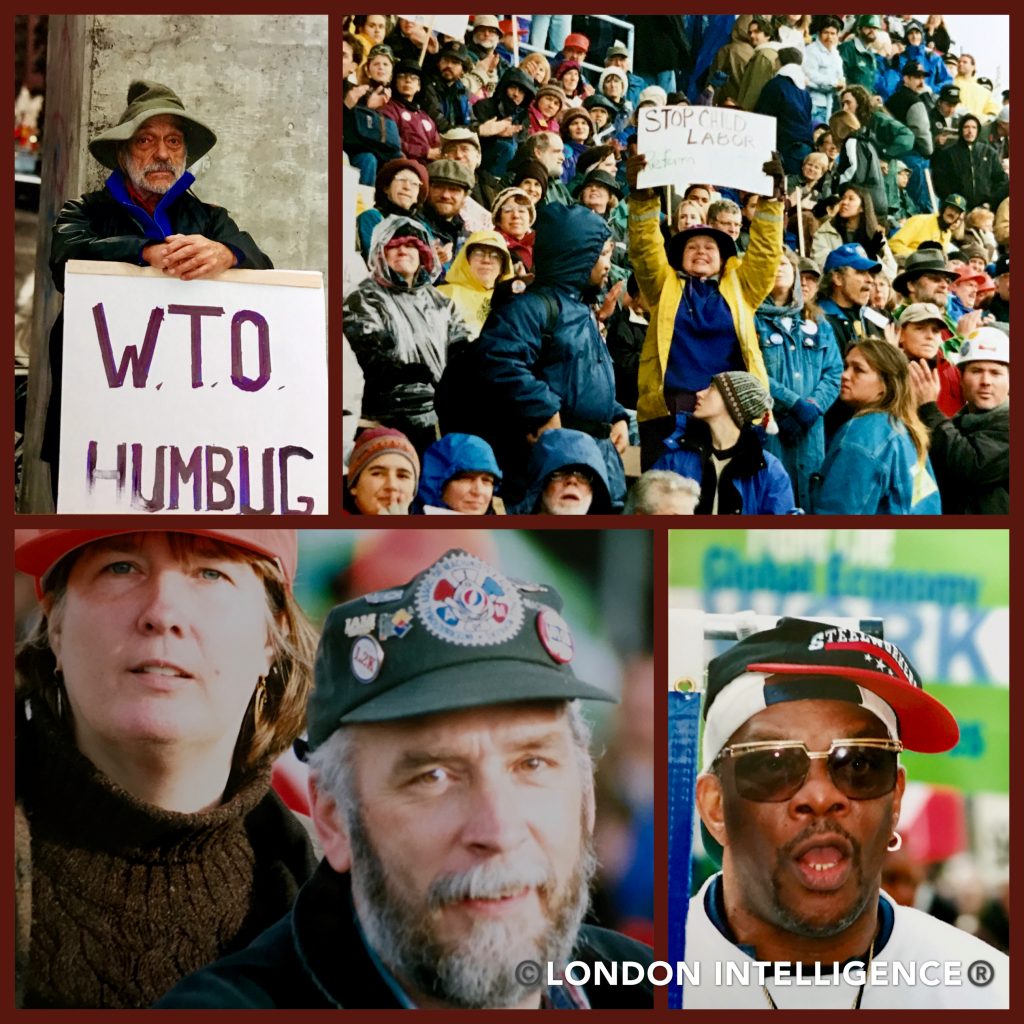
Notes for readers: ‘My assignment was to cover the World Trade Organisation meeting and the planned protests,’ recalls Paul Coleman. ‘I arrived in Seattle on Thursday, 25 November 1999 – Thanksgiving Day – a national public holiday in the United States. So, all of Seattle’s shops and cafes were closed, except for Starbucks, and a downtown late night cinema where I watched ‘The Insider’, a Hollywood film, starring Russell Crowe and Al Pacino, depicting the true story of tobacco industry insider Jeffrey Wigand who blows the whistle on corporate corruption.
However, a few days later, the WTO descends on Seattle and shatters the city’s peace. Seattle’s Mayor imposes a curfew on much of the city’s downtown area. I try to get through lines of riot police by showing my press card. ‘You’re not f..king going anywhere,’ growls a young Asian-American riot cop from behind the visor of his protective helmet. For good measure, he then thrusts his riot baton into my gut. With this, I get his message – and fully grasp how Seattle’s twitchy riot police are clearly out of their depth to deal with unique protests that have attracted global media attention.’
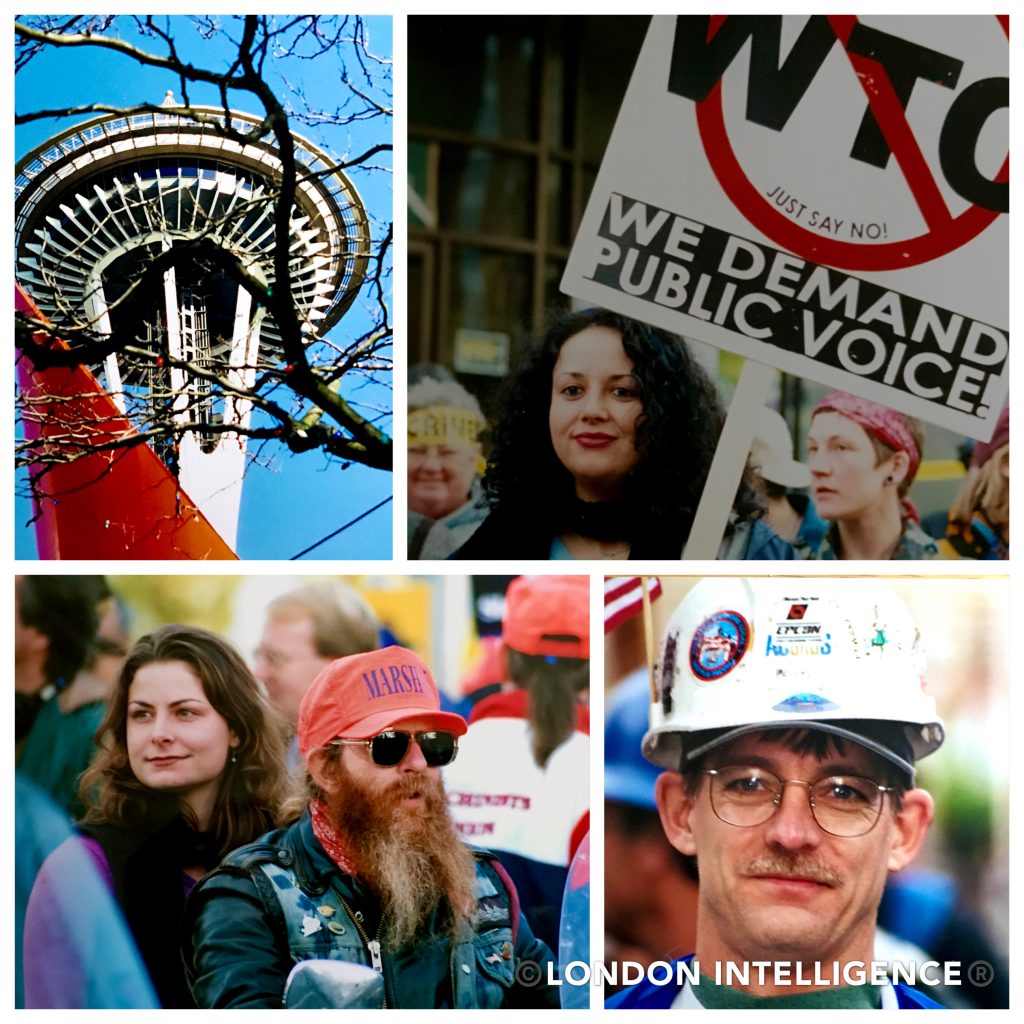
*
© Paul Coleman, London Intelligence, 2019
